Business Environment Report: Types of Organizations and Analysis
VerifiedAdded on 2020/07/23
|17
|5152
|43
Report
AI Summary
This report provides a comprehensive analysis of the business environment, focusing on private, public, and voluntary organizations. It begins with an introduction to the business environment and its impact on organizational activities. Task 1 delves into the types, purposes, and legal structures of private, public, and voluntary organizations, using Nestle, NHS, and Oxfam as examples. Task 2 examines the size and scope of these organizations. Task 3 explores the interrelation between organizational departments and their link to objectives. Task 4 analyzes the impact of macro-environmental factors, while Task 5 conducts an internal analysis to identify strengths and weaknesses. Finally, Task 6 investigates the interrelation of macro-environmental factors with organizational strengths and weaknesses. The report concludes with a summary of the key findings and a list of references.
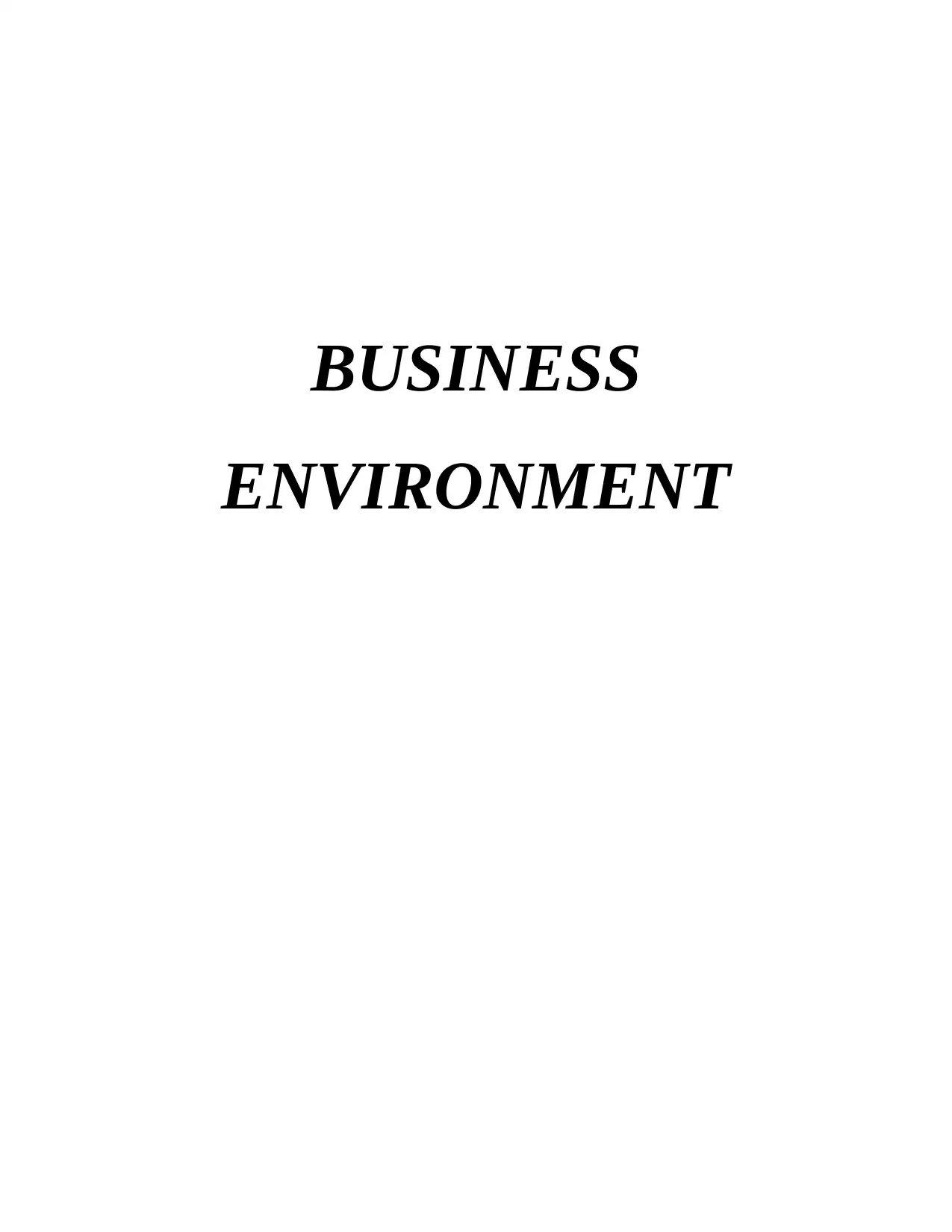
BUSINESS
ENVIRONMENT
ENVIRONMENT
Paraphrase This Document
Need a fresh take? Get an instant paraphrase of this document with our AI Paraphraser
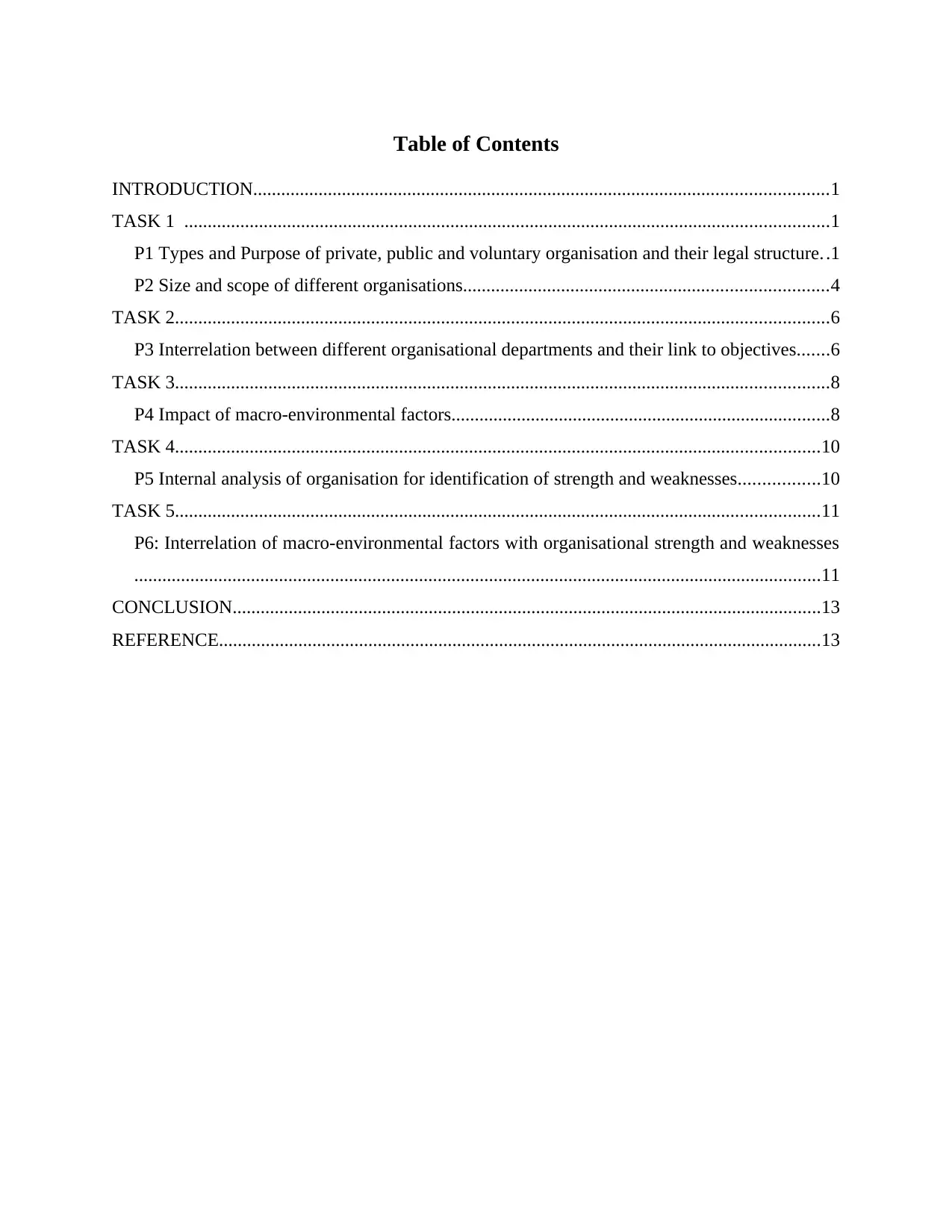
Table of Contents
INTRODUCTION...........................................................................................................................1
TASK 1 ..........................................................................................................................................1
P1 Types and Purpose of private, public and voluntary organisation and their legal structure. .1
P2 Size and scope of different organisations..............................................................................4
TASK 2............................................................................................................................................6
P3 Interrelation between different organisational departments and their link to objectives.......6
TASK 3............................................................................................................................................8
P4 Impact of macro-environmental factors.................................................................................8
TASK 4..........................................................................................................................................10
P5 Internal analysis of organisation for identification of strength and weaknesses.................10
TASK 5..........................................................................................................................................11
P6: Interrelation of macro-environmental factors with organisational strength and weaknesses
...................................................................................................................................................11
CONCLUSION..............................................................................................................................13
REFERENCE.................................................................................................................................13
INTRODUCTION...........................................................................................................................1
TASK 1 ..........................................................................................................................................1
P1 Types and Purpose of private, public and voluntary organisation and their legal structure. .1
P2 Size and scope of different organisations..............................................................................4
TASK 2............................................................................................................................................6
P3 Interrelation between different organisational departments and their link to objectives.......6
TASK 3............................................................................................................................................8
P4 Impact of macro-environmental factors.................................................................................8
TASK 4..........................................................................................................................................10
P5 Internal analysis of organisation for identification of strength and weaknesses.................10
TASK 5..........................................................................................................................................11
P6: Interrelation of macro-environmental factors with organisational strength and weaknesses
...................................................................................................................................................11
CONCLUSION..............................................................................................................................13
REFERENCE.................................................................................................................................13
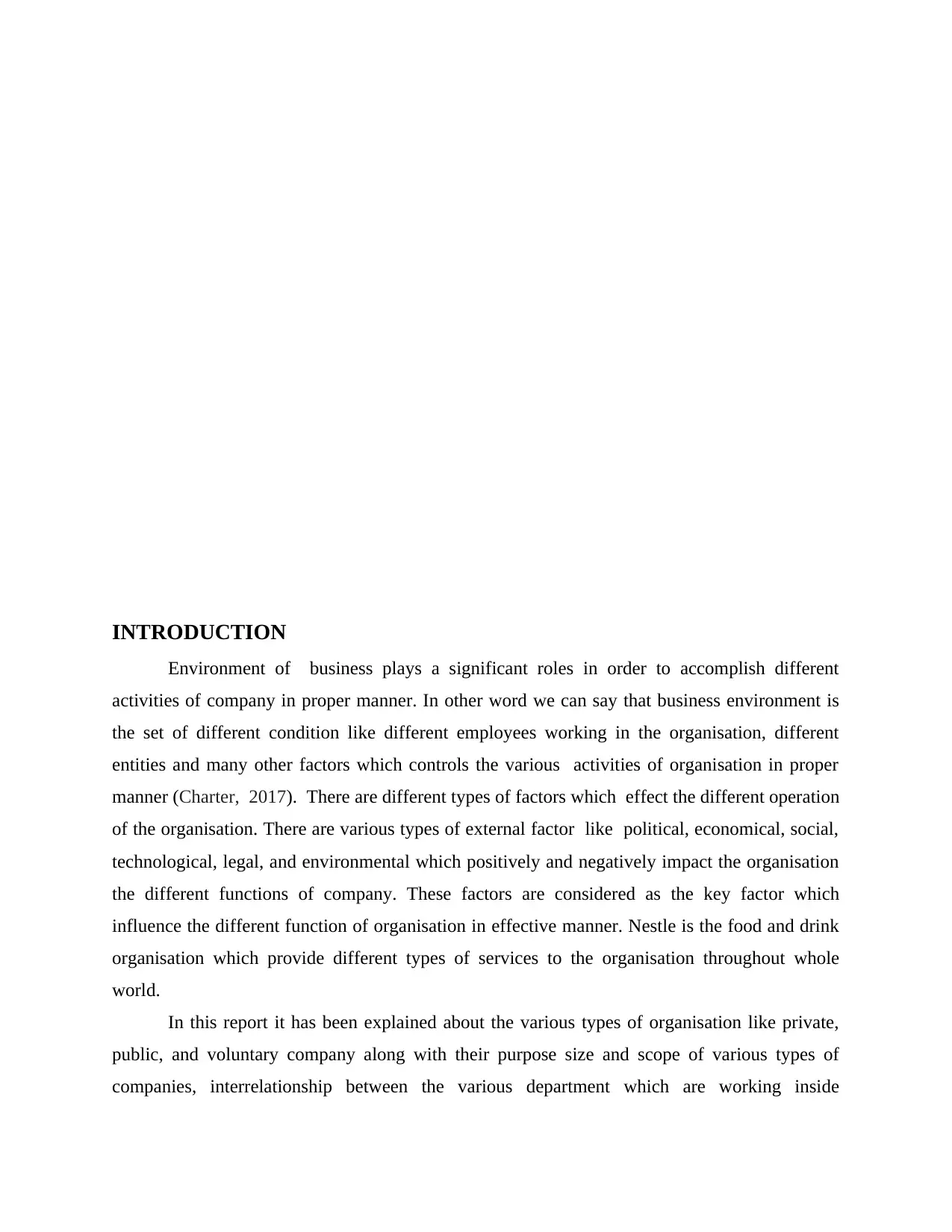
INTRODUCTION
Environment of business plays a significant roles in order to accomplish different
activities of company in proper manner. In other word we can say that business environment is
the set of different condition like different employees working in the organisation, different
entities and many other factors which controls the various activities of organisation in proper
manner (Charter, 2017). There are different types of factors which effect the different operation
of the organisation. There are various types of external factor like political, economical, social,
technological, legal, and environmental which positively and negatively impact the organisation
the different functions of company. These factors are considered as the key factor which
influence the different function of organisation in effective manner. Nestle is the food and drink
organisation which provide different types of services to the organisation throughout whole
world.
In this report it has been explained about the various types of organisation like private,
public, and voluntary company along with their purpose size and scope of various types of
companies, interrelationship between the various department which are working inside
Environment of business plays a significant roles in order to accomplish different
activities of company in proper manner. In other word we can say that business environment is
the set of different condition like different employees working in the organisation, different
entities and many other factors which controls the various activities of organisation in proper
manner (Charter, 2017). There are different types of factors which effect the different operation
of the organisation. There are various types of external factor like political, economical, social,
technological, legal, and environmental which positively and negatively impact the organisation
the different functions of company. These factors are considered as the key factor which
influence the different function of organisation in effective manner. Nestle is the food and drink
organisation which provide different types of services to the organisation throughout whole
world.
In this report it has been explained about the various types of organisation like private,
public, and voluntary company along with their purpose size and scope of various types of
companies, interrelationship between the various department which are working inside
⊘ This is a preview!⊘
Do you want full access?
Subscribe today to unlock all pages.

Trusted by 1+ million students worldwide
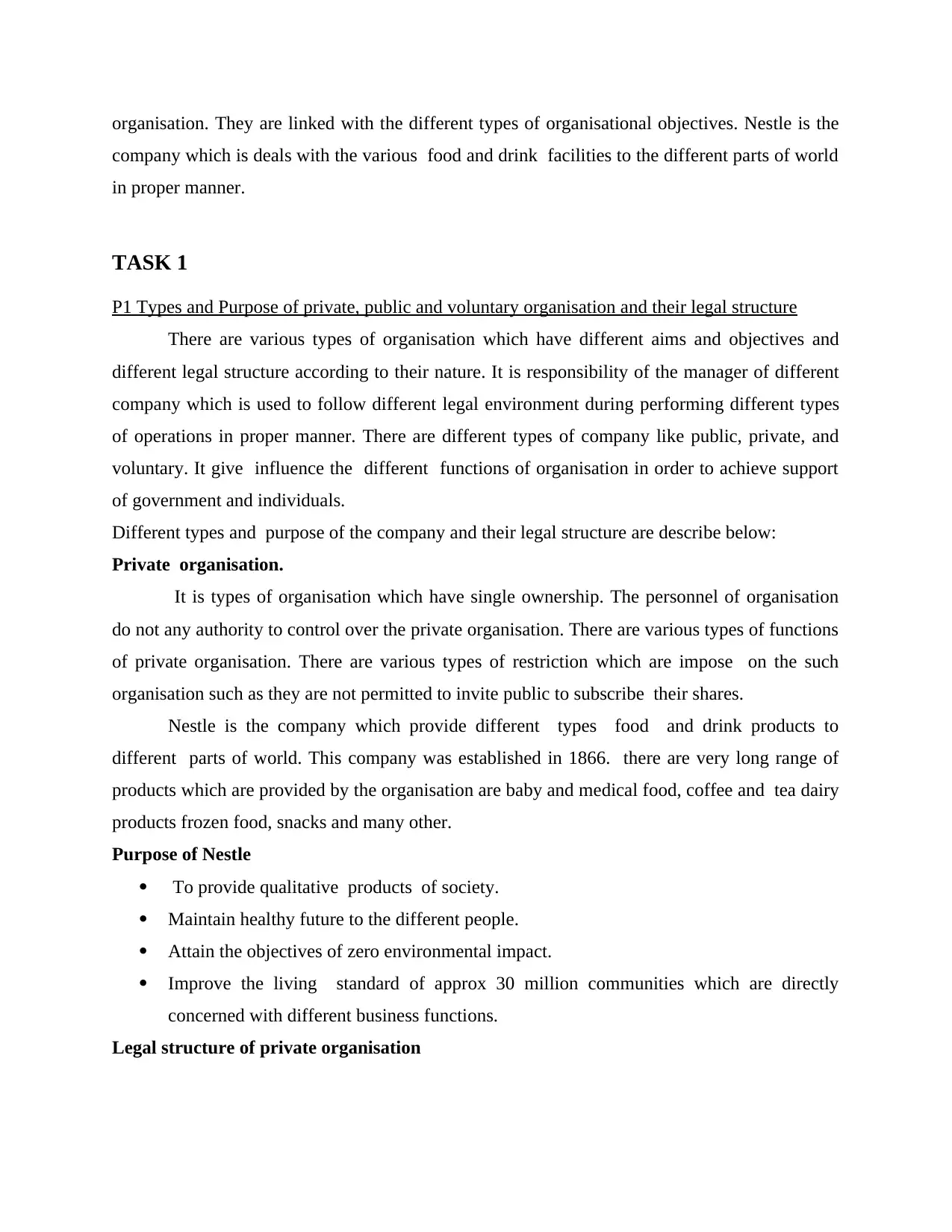
organisation. They are linked with the different types of organisational objectives. Nestle is the
company which is deals with the various food and drink facilities to the different parts of world
in proper manner.
TASK 1
P1 Types and Purpose of private, public and voluntary organisation and their legal structure
There are various types of organisation which have different aims and objectives and
different legal structure according to their nature. It is responsibility of the manager of different
company which is used to follow different legal environment during performing different types
of operations in proper manner. There are different types of company like public, private, and
voluntary. It give influence the different functions of organisation in order to achieve support
of government and individuals.
Different types and purpose of the company and their legal structure are describe below:
Private organisation.
It is types of organisation which have single ownership. The personnel of organisation
do not any authority to control over the private organisation. There are various types of functions
of private organisation. There are various types of restriction which are impose on the such
organisation such as they are not permitted to invite public to subscribe their shares.
Nestle is the company which provide different types food and drink products to
different parts of world. This company was established in 1866. there are very long range of
products which are provided by the organisation are baby and medical food, coffee and tea dairy
products frozen food, snacks and many other.
Purpose of Nestle
To provide qualitative products of society.
Maintain healthy future to the different people.
Attain the objectives of zero environmental impact.
Improve the living standard of approx 30 million communities which are directly
concerned with different business functions.
Legal structure of private organisation
company which is deals with the various food and drink facilities to the different parts of world
in proper manner.
TASK 1
P1 Types and Purpose of private, public and voluntary organisation and their legal structure
There are various types of organisation which have different aims and objectives and
different legal structure according to their nature. It is responsibility of the manager of different
company which is used to follow different legal environment during performing different types
of operations in proper manner. There are different types of company like public, private, and
voluntary. It give influence the different functions of organisation in order to achieve support
of government and individuals.
Different types and purpose of the company and their legal structure are describe below:
Private organisation.
It is types of organisation which have single ownership. The personnel of organisation
do not any authority to control over the private organisation. There are various types of functions
of private organisation. There are various types of restriction which are impose on the such
organisation such as they are not permitted to invite public to subscribe their shares.
Nestle is the company which provide different types food and drink products to
different parts of world. This company was established in 1866. there are very long range of
products which are provided by the organisation are baby and medical food, coffee and tea dairy
products frozen food, snacks and many other.
Purpose of Nestle
To provide qualitative products of society.
Maintain healthy future to the different people.
Attain the objectives of zero environmental impact.
Improve the living standard of approx 30 million communities which are directly
concerned with different business functions.
Legal structure of private organisation
Paraphrase This Document
Need a fresh take? Get an instant paraphrase of this document with our AI Paraphraser
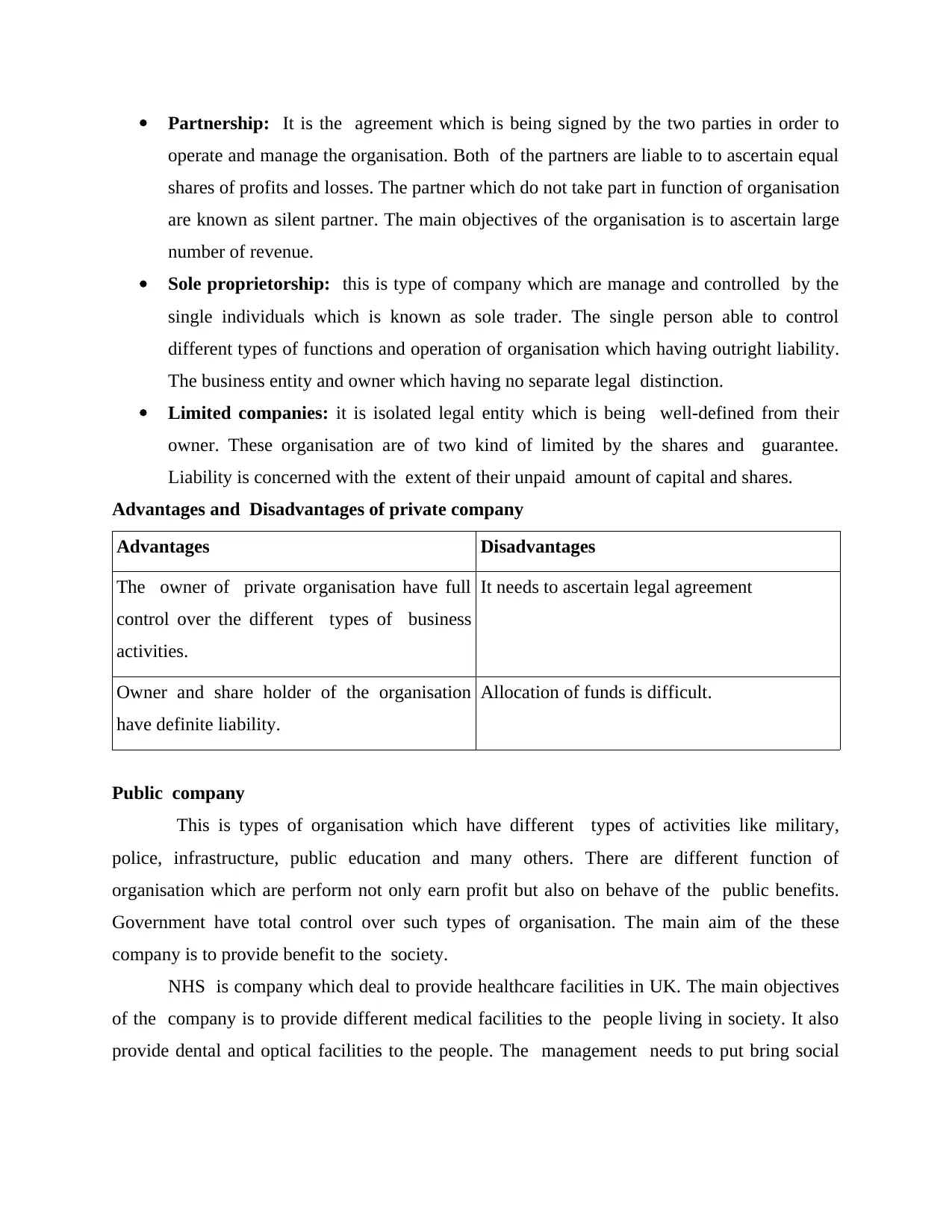
Partnership: It is the agreement which is being signed by the two parties in order to
operate and manage the organisation. Both of the partners are liable to to ascertain equal
shares of profits and losses. The partner which do not take part in function of organisation
are known as silent partner. The main objectives of the organisation is to ascertain large
number of revenue.
Sole proprietorship: this is type of company which are manage and controlled by the
single individuals which is known as sole trader. The single person able to control
different types of functions and operation of organisation which having outright liability.
The business entity and owner which having no separate legal distinction.
Limited companies: it is isolated legal entity which is being well-defined from their
owner. These organisation are of two kind of limited by the shares and guarantee.
Liability is concerned with the extent of their unpaid amount of capital and shares.
Advantages and Disadvantages of private company
Advantages Disadvantages
The owner of private organisation have full
control over the different types of business
activities.
It needs to ascertain legal agreement
Owner and share holder of the organisation
have definite liability.
Allocation of funds is difficult.
Public company
This is types of organisation which have different types of activities like military,
police, infrastructure, public education and many others. There are different function of
organisation which are perform not only earn profit but also on behave of the public benefits.
Government have total control over such types of organisation. The main aim of the these
company is to provide benefit to the society.
NHS is company which deal to provide healthcare facilities in UK. The main objectives
of the company is to provide different medical facilities to the people living in society. It also
provide dental and optical facilities to the people. The management needs to put bring social
operate and manage the organisation. Both of the partners are liable to to ascertain equal
shares of profits and losses. The partner which do not take part in function of organisation
are known as silent partner. The main objectives of the organisation is to ascertain large
number of revenue.
Sole proprietorship: this is type of company which are manage and controlled by the
single individuals which is known as sole trader. The single person able to control
different types of functions and operation of organisation which having outright liability.
The business entity and owner which having no separate legal distinction.
Limited companies: it is isolated legal entity which is being well-defined from their
owner. These organisation are of two kind of limited by the shares and guarantee.
Liability is concerned with the extent of their unpaid amount of capital and shares.
Advantages and Disadvantages of private company
Advantages Disadvantages
The owner of private organisation have full
control over the different types of business
activities.
It needs to ascertain legal agreement
Owner and share holder of the organisation
have definite liability.
Allocation of funds is difficult.
Public company
This is types of organisation which have different types of activities like military,
police, infrastructure, public education and many others. There are different function of
organisation which are perform not only earn profit but also on behave of the public benefits.
Government have total control over such types of organisation. The main aim of the these
company is to provide benefit to the society.
NHS is company which deal to provide healthcare facilities in UK. The main objectives
of the company is to provide different medical facilities to the people living in society. It also
provide dental and optical facilities to the people. The management needs to put bring social
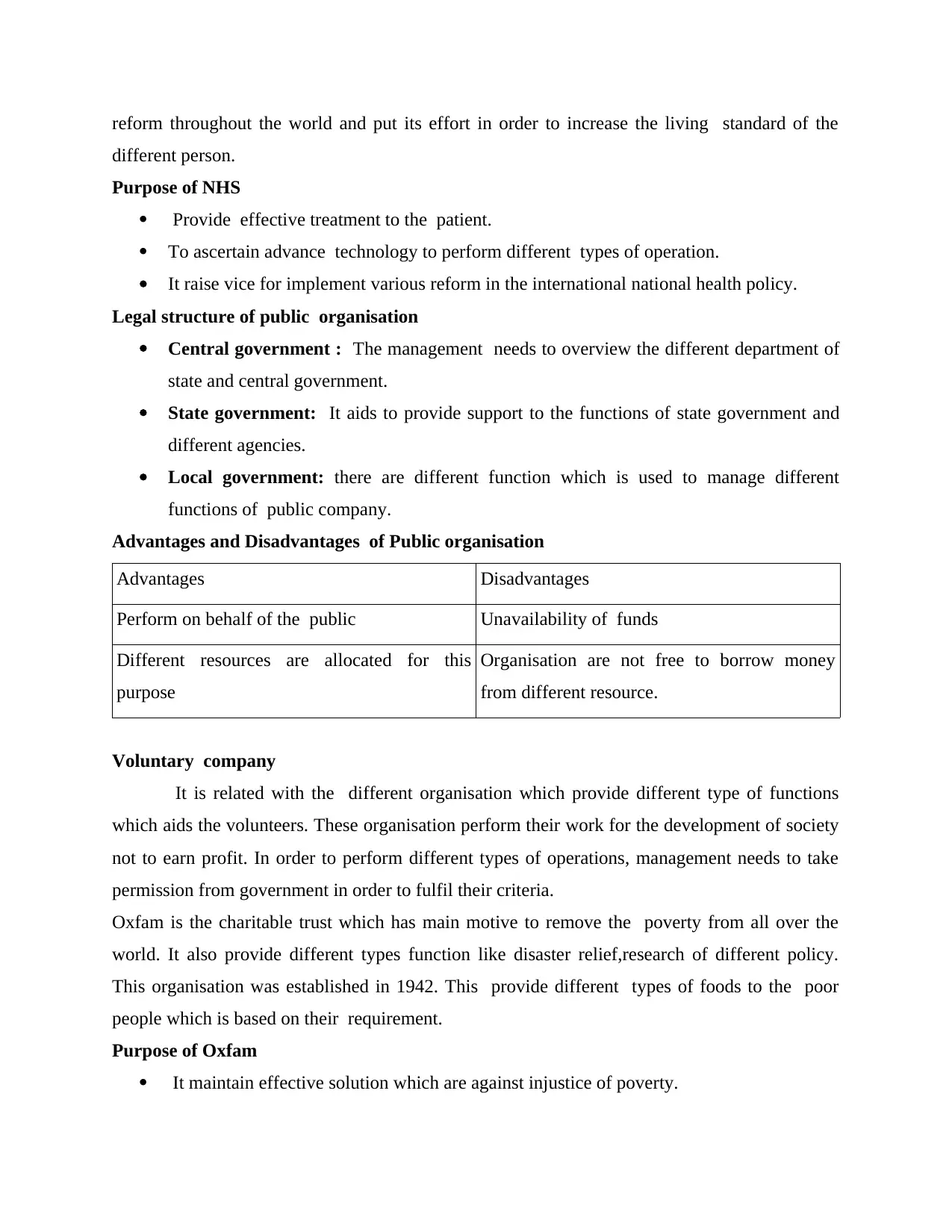
reform throughout the world and put its effort in order to increase the living standard of the
different person.
Purpose of NHS
Provide effective treatment to the patient.
To ascertain advance technology to perform different types of operation.
It raise vice for implement various reform in the international national health policy.
Legal structure of public organisation
Central government : The management needs to overview the different department of
state and central government.
State government: It aids to provide support to the functions of state government and
different agencies.
Local government: there are different function which is used to manage different
functions of public company.
Advantages and Disadvantages of Public organisation
Advantages Disadvantages
Perform on behalf of the public Unavailability of funds
Different resources are allocated for this
purpose
Organisation are not free to borrow money
from different resource.
Voluntary company
It is related with the different organisation which provide different type of functions
which aids the volunteers. These organisation perform their work for the development of society
not to earn profit. In order to perform different types of operations, management needs to take
permission from government in order to fulfil their criteria.
Oxfam is the charitable trust which has main motive to remove the poverty from all over the
world. It also provide different types function like disaster relief,research of different policy.
This organisation was established in 1942. This provide different types of foods to the poor
people which is based on their requirement.
Purpose of Oxfam
It maintain effective solution which are against injustice of poverty.
different person.
Purpose of NHS
Provide effective treatment to the patient.
To ascertain advance technology to perform different types of operation.
It raise vice for implement various reform in the international national health policy.
Legal structure of public organisation
Central government : The management needs to overview the different department of
state and central government.
State government: It aids to provide support to the functions of state government and
different agencies.
Local government: there are different function which is used to manage different
functions of public company.
Advantages and Disadvantages of Public organisation
Advantages Disadvantages
Perform on behalf of the public Unavailability of funds
Different resources are allocated for this
purpose
Organisation are not free to borrow money
from different resource.
Voluntary company
It is related with the different organisation which provide different type of functions
which aids the volunteers. These organisation perform their work for the development of society
not to earn profit. In order to perform different types of operations, management needs to take
permission from government in order to fulfil their criteria.
Oxfam is the charitable trust which has main motive to remove the poverty from all over the
world. It also provide different types function like disaster relief,research of different policy.
This organisation was established in 1942. This provide different types of foods to the poor
people which is based on their requirement.
Purpose of Oxfam
It maintain effective solution which are against injustice of poverty.
⊘ This is a preview!⊘
Do you want full access?
Subscribe today to unlock all pages.

Trusted by 1+ million students worldwide
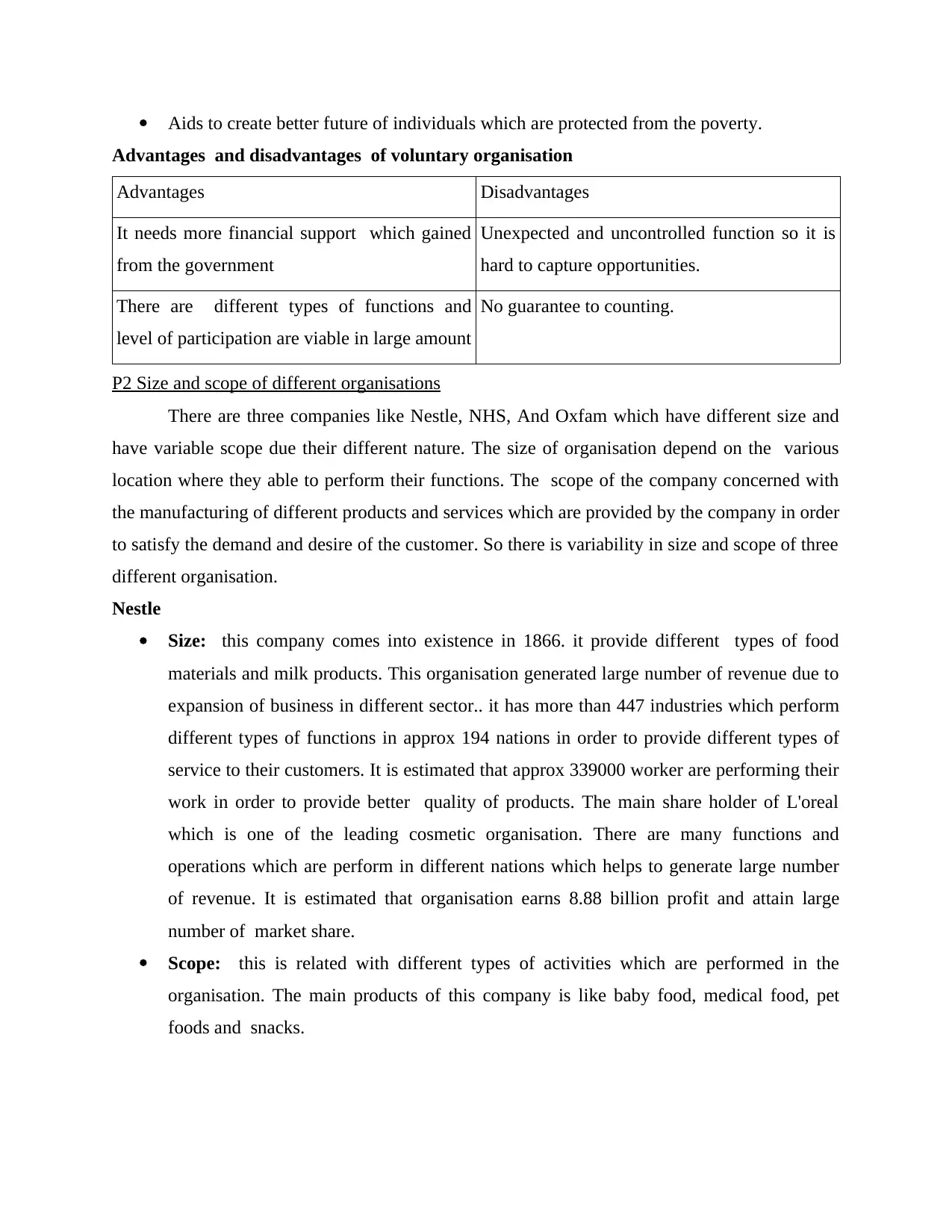
Aids to create better future of individuals which are protected from the poverty.
Advantages and disadvantages of voluntary organisation
Advantages Disadvantages
It needs more financial support which gained
from the government
Unexpected and uncontrolled function so it is
hard to capture opportunities.
There are different types of functions and
level of participation are viable in large amount
No guarantee to counting.
P2 Size and scope of different organisations
There are three companies like Nestle, NHS, And Oxfam which have different size and
have variable scope due their different nature. The size of organisation depend on the various
location where they able to perform their functions. The scope of the company concerned with
the manufacturing of different products and services which are provided by the company in order
to satisfy the demand and desire of the customer. So there is variability in size and scope of three
different organisation.
Nestle
Size: this company comes into existence in 1866. it provide different types of food
materials and milk products. This organisation generated large number of revenue due to
expansion of business in different sector.. it has more than 447 industries which perform
different types of functions in approx 194 nations in order to provide different types of
service to their customers. It is estimated that approx 339000 worker are performing their
work in order to provide better quality of products. The main share holder of L'oreal
which is one of the leading cosmetic organisation. There are many functions and
operations which are perform in different nations which helps to generate large number
of revenue. It is estimated that organisation earns 8.88 billion profit and attain large
number of market share.
Scope: this is related with different types of activities which are performed in the
organisation. The main products of this company is like baby food, medical food, pet
foods and snacks.
Advantages and disadvantages of voluntary organisation
Advantages Disadvantages
It needs more financial support which gained
from the government
Unexpected and uncontrolled function so it is
hard to capture opportunities.
There are different types of functions and
level of participation are viable in large amount
No guarantee to counting.
P2 Size and scope of different organisations
There are three companies like Nestle, NHS, And Oxfam which have different size and
have variable scope due their different nature. The size of organisation depend on the various
location where they able to perform their functions. The scope of the company concerned with
the manufacturing of different products and services which are provided by the company in order
to satisfy the demand and desire of the customer. So there is variability in size and scope of three
different organisation.
Nestle
Size: this company comes into existence in 1866. it provide different types of food
materials and milk products. This organisation generated large number of revenue due to
expansion of business in different sector.. it has more than 447 industries which perform
different types of functions in approx 194 nations in order to provide different types of
service to their customers. It is estimated that approx 339000 worker are performing their
work in order to provide better quality of products. The main share holder of L'oreal
which is one of the leading cosmetic organisation. There are many functions and
operations which are perform in different nations which helps to generate large number
of revenue. It is estimated that organisation earns 8.88 billion profit and attain large
number of market share.
Scope: this is related with different types of activities which are performed in the
organisation. The main products of this company is like baby food, medical food, pet
foods and snacks.
Paraphrase This Document
Need a fresh take? Get an instant paraphrase of this document with our AI Paraphraser
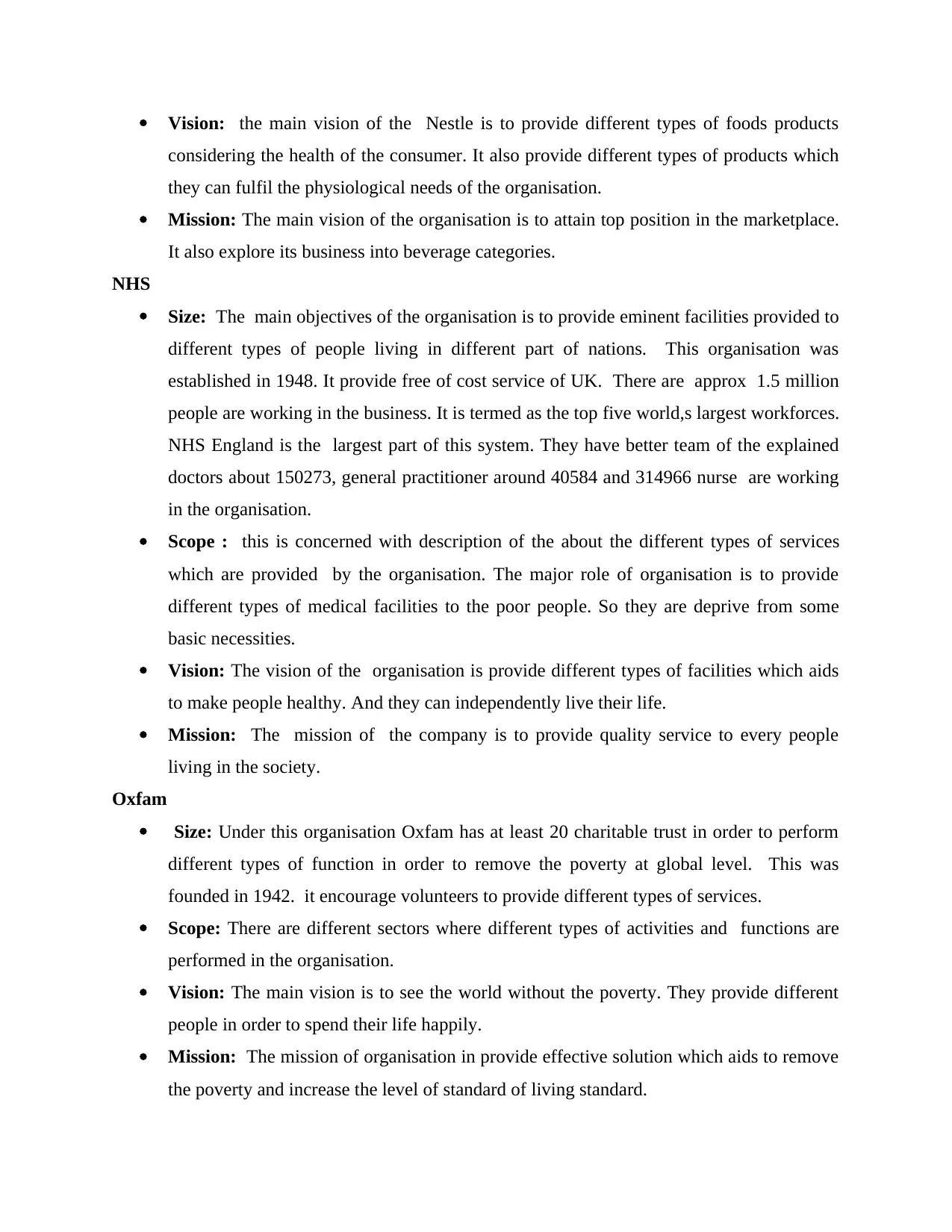
Vision: the main vision of the Nestle is to provide different types of foods products
considering the health of the consumer. It also provide different types of products which
they can fulfil the physiological needs of the organisation.
Mission: The main vision of the organisation is to attain top position in the marketplace.
It also explore its business into beverage categories.
NHS
Size: The main objectives of the organisation is to provide eminent facilities provided to
different types of people living in different part of nations. This organisation was
established in 1948. It provide free of cost service of UK. There are approx 1.5 million
people are working in the business. It is termed as the top five world,s largest workforces.
NHS England is the largest part of this system. They have better team of the explained
doctors about 150273, general practitioner around 40584 and 314966 nurse are working
in the organisation.
Scope : this is concerned with description of the about the different types of services
which are provided by the organisation. The major role of organisation is to provide
different types of medical facilities to the poor people. So they are deprive from some
basic necessities.
Vision: The vision of the organisation is provide different types of facilities which aids
to make people healthy. And they can independently live their life.
Mission: The mission of the company is to provide quality service to every people
living in the society.
Oxfam
Size: Under this organisation Oxfam has at least 20 charitable trust in order to perform
different types of function in order to remove the poverty at global level. This was
founded in 1942. it encourage volunteers to provide different types of services.
Scope: There are different sectors where different types of activities and functions are
performed in the organisation.
Vision: The main vision is to see the world without the poverty. They provide different
people in order to spend their life happily.
Mission: The mission of organisation in provide effective solution which aids to remove
the poverty and increase the level of standard of living standard.
considering the health of the consumer. It also provide different types of products which
they can fulfil the physiological needs of the organisation.
Mission: The main vision of the organisation is to attain top position in the marketplace.
It also explore its business into beverage categories.
NHS
Size: The main objectives of the organisation is to provide eminent facilities provided to
different types of people living in different part of nations. This organisation was
established in 1948. It provide free of cost service of UK. There are approx 1.5 million
people are working in the business. It is termed as the top five world,s largest workforces.
NHS England is the largest part of this system. They have better team of the explained
doctors about 150273, general practitioner around 40584 and 314966 nurse are working
in the organisation.
Scope : this is concerned with description of the about the different types of services
which are provided by the organisation. The major role of organisation is to provide
different types of medical facilities to the poor people. So they are deprive from some
basic necessities.
Vision: The vision of the organisation is provide different types of facilities which aids
to make people healthy. And they can independently live their life.
Mission: The mission of the company is to provide quality service to every people
living in the society.
Oxfam
Size: Under this organisation Oxfam has at least 20 charitable trust in order to perform
different types of function in order to remove the poverty at global level. This was
founded in 1942. it encourage volunteers to provide different types of services.
Scope: There are different sectors where different types of activities and functions are
performed in the organisation.
Vision: The main vision is to see the world without the poverty. They provide different
people in order to spend their life happily.
Mission: The mission of organisation in provide effective solution which aids to remove
the poverty and increase the level of standard of living standard.
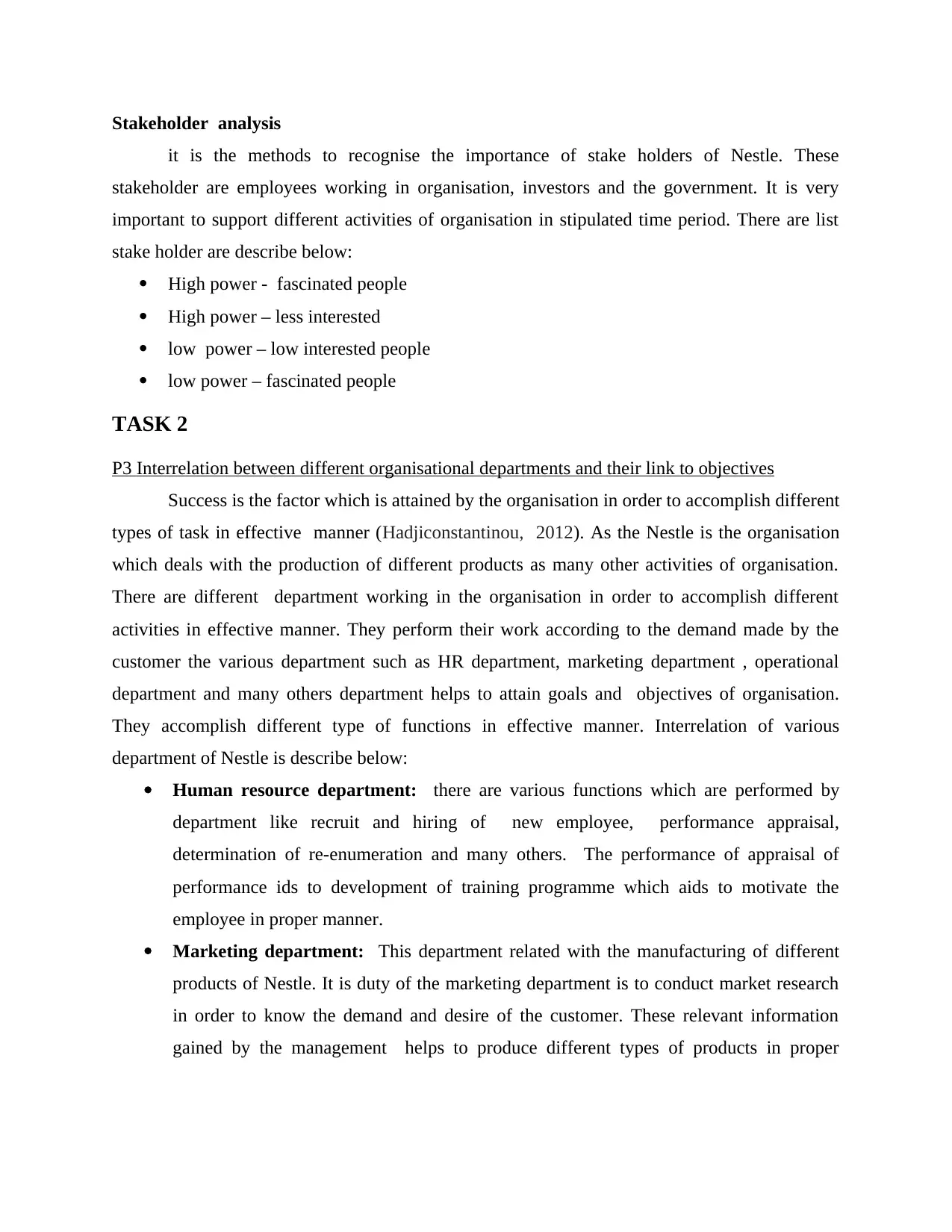
Stakeholder analysis
it is the methods to recognise the importance of stake holders of Nestle. These
stakeholder are employees working in organisation, investors and the government. It is very
important to support different activities of organisation in stipulated time period. There are list
stake holder are describe below:
High power - fascinated people
High power – less interested
low power – low interested people
low power – fascinated people
TASK 2
P3 Interrelation between different organisational departments and their link to objectives
Success is the factor which is attained by the organisation in order to accomplish different
types of task in effective manner (Hadjiconstantinou, 2012). As the Nestle is the organisation
which deals with the production of different products as many other activities of organisation.
There are different department working in the organisation in order to accomplish different
activities in effective manner. They perform their work according to the demand made by the
customer the various department such as HR department, marketing department , operational
department and many others department helps to attain goals and objectives of organisation.
They accomplish different type of functions in effective manner. Interrelation of various
department of Nestle is describe below:
Human resource department: there are various functions which are performed by
department like recruit and hiring of new employee, performance appraisal,
determination of re-enumeration and many others. The performance of appraisal of
performance ids to development of training programme which aids to motivate the
employee in proper manner.
Marketing department: This department related with the manufacturing of different
products of Nestle. It is duty of the marketing department is to conduct market research
in order to know the demand and desire of the customer. These relevant information
gained by the management helps to produce different types of products in proper
it is the methods to recognise the importance of stake holders of Nestle. These
stakeholder are employees working in organisation, investors and the government. It is very
important to support different activities of organisation in stipulated time period. There are list
stake holder are describe below:
High power - fascinated people
High power – less interested
low power – low interested people
low power – fascinated people
TASK 2
P3 Interrelation between different organisational departments and their link to objectives
Success is the factor which is attained by the organisation in order to accomplish different
types of task in effective manner (Hadjiconstantinou, 2012). As the Nestle is the organisation
which deals with the production of different products as many other activities of organisation.
There are different department working in the organisation in order to accomplish different
activities in effective manner. They perform their work according to the demand made by the
customer the various department such as HR department, marketing department , operational
department and many others department helps to attain goals and objectives of organisation.
They accomplish different type of functions in effective manner. Interrelation of various
department of Nestle is describe below:
Human resource department: there are various functions which are performed by
department like recruit and hiring of new employee, performance appraisal,
determination of re-enumeration and many others. The performance of appraisal of
performance ids to development of training programme which aids to motivate the
employee in proper manner.
Marketing department: This department related with the manufacturing of different
products of Nestle. It is duty of the marketing department is to conduct market research
in order to know the demand and desire of the customer. These relevant information
gained by the management helps to produce different types of products in proper
⊘ This is a preview!⊘
Do you want full access?
Subscribe today to unlock all pages.

Trusted by 1+ million students worldwide
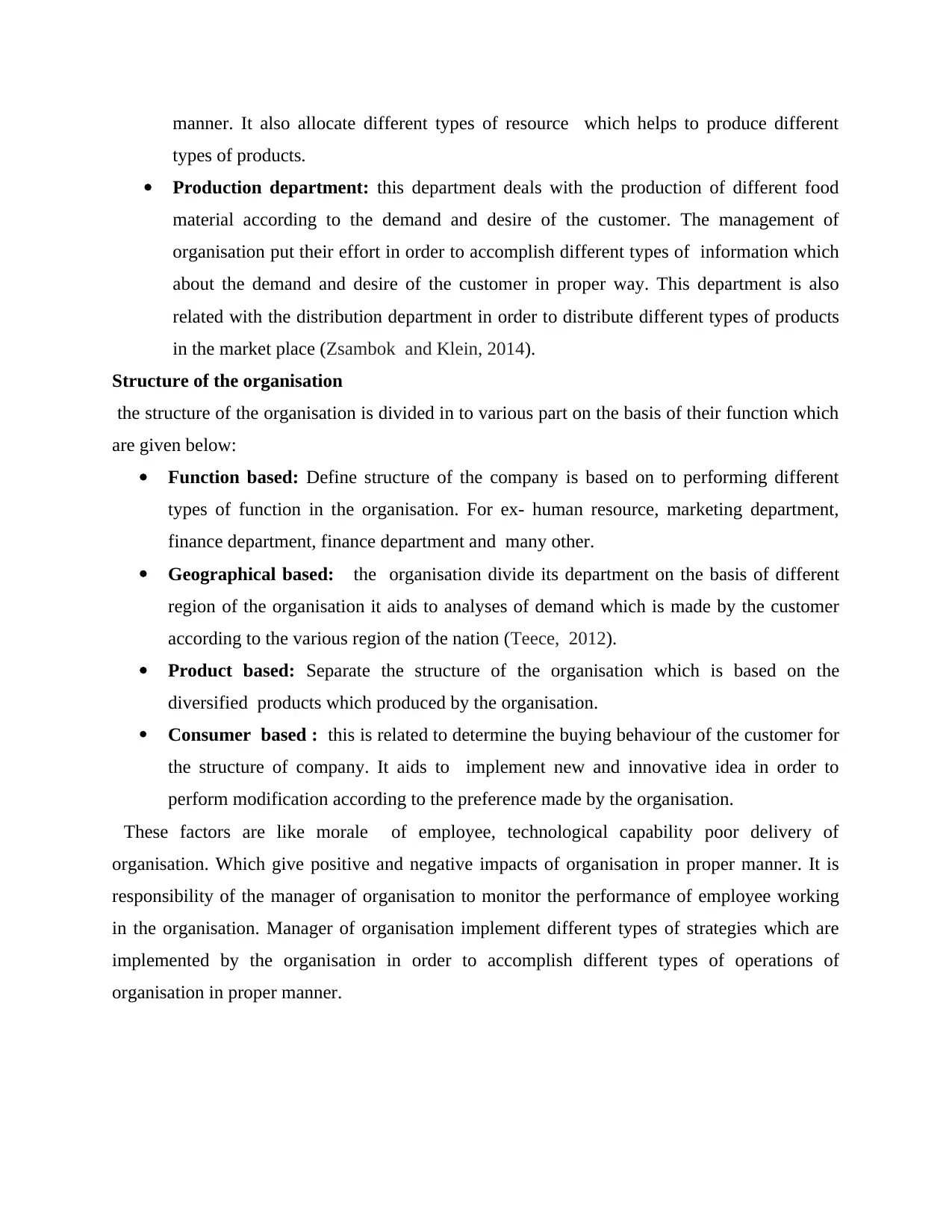
manner. It also allocate different types of resource which helps to produce different
types of products.
Production department: this department deals with the production of different food
material according to the demand and desire of the customer. The management of
organisation put their effort in order to accomplish different types of information which
about the demand and desire of the customer in proper way. This department is also
related with the distribution department in order to distribute different types of products
in the market place (Zsambok and Klein, 2014).
Structure of the organisation
the structure of the organisation is divided in to various part on the basis of their function which
are given below:
Function based: Define structure of the company is based on to performing different
types of function in the organisation. For ex- human resource, marketing department,
finance department, finance department and many other.
Geographical based: the organisation divide its department on the basis of different
region of the organisation it aids to analyses of demand which is made by the customer
according to the various region of the nation (Teece, 2012).
Product based: Separate the structure of the organisation which is based on the
diversified products which produced by the organisation.
Consumer based : this is related to determine the buying behaviour of the customer for
the structure of company. It aids to implement new and innovative idea in order to
perform modification according to the preference made by the organisation.
These factors are like morale of employee, technological capability poor delivery of
organisation. Which give positive and negative impacts of organisation in proper manner. It is
responsibility of the manager of organisation to monitor the performance of employee working
in the organisation. Manager of organisation implement different types of strategies which are
implemented by the organisation in order to accomplish different types of operations of
organisation in proper manner.
types of products.
Production department: this department deals with the production of different food
material according to the demand and desire of the customer. The management of
organisation put their effort in order to accomplish different types of information which
about the demand and desire of the customer in proper way. This department is also
related with the distribution department in order to distribute different types of products
in the market place (Zsambok and Klein, 2014).
Structure of the organisation
the structure of the organisation is divided in to various part on the basis of their function which
are given below:
Function based: Define structure of the company is based on to performing different
types of function in the organisation. For ex- human resource, marketing department,
finance department, finance department and many other.
Geographical based: the organisation divide its department on the basis of different
region of the organisation it aids to analyses of demand which is made by the customer
according to the various region of the nation (Teece, 2012).
Product based: Separate the structure of the organisation which is based on the
diversified products which produced by the organisation.
Consumer based : this is related to determine the buying behaviour of the customer for
the structure of company. It aids to implement new and innovative idea in order to
perform modification according to the preference made by the organisation.
These factors are like morale of employee, technological capability poor delivery of
organisation. Which give positive and negative impacts of organisation in proper manner. It is
responsibility of the manager of organisation to monitor the performance of employee working
in the organisation. Manager of organisation implement different types of strategies which are
implemented by the organisation in order to accomplish different types of operations of
organisation in proper manner.
Paraphrase This Document
Need a fresh take? Get an instant paraphrase of this document with our AI Paraphraser
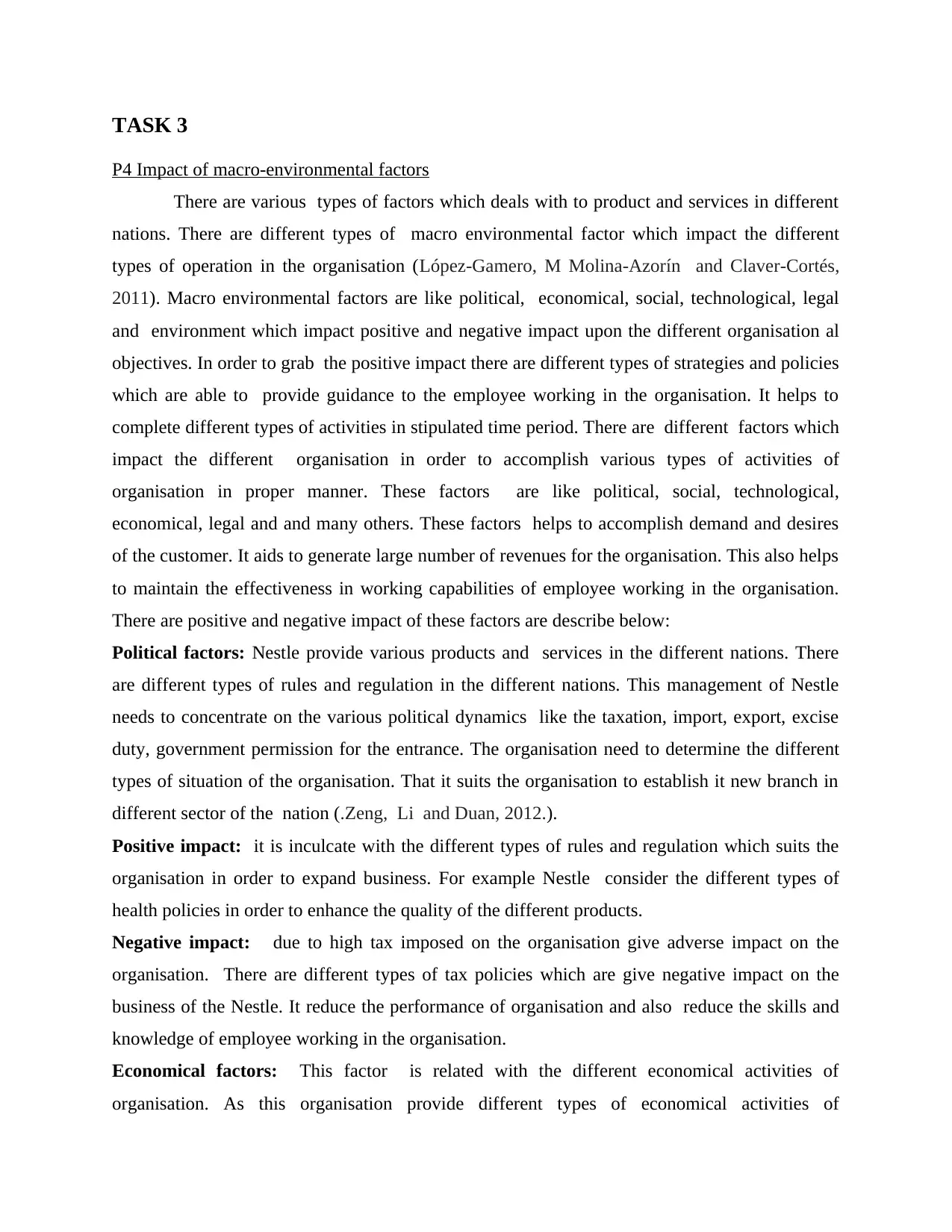
TASK 3
P4 Impact of macro-environmental factors
There are various types of factors which deals with to product and services in different
nations. There are different types of macro environmental factor which impact the different
types of operation in the organisation (López-Gamero, M Molina-Azorín and Claver-Cortés,
2011). Macro environmental factors are like political, economical, social, technological, legal
and environment which impact positive and negative impact upon the different organisation al
objectives. In order to grab the positive impact there are different types of strategies and policies
which are able to provide guidance to the employee working in the organisation. It helps to
complete different types of activities in stipulated time period. There are different factors which
impact the different organisation in order to accomplish various types of activities of
organisation in proper manner. These factors are like political, social, technological,
economical, legal and and many others. These factors helps to accomplish demand and desires
of the customer. It aids to generate large number of revenues for the organisation. This also helps
to maintain the effectiveness in working capabilities of employee working in the organisation.
There are positive and negative impact of these factors are describe below:
Political factors: Nestle provide various products and services in the different nations. There
are different types of rules and regulation in the different nations. This management of Nestle
needs to concentrate on the various political dynamics like the taxation, import, export, excise
duty, government permission for the entrance. The organisation need to determine the different
types of situation of the organisation. That it suits the organisation to establish it new branch in
different sector of the nation (.Zeng, Li and Duan, 2012.).
Positive impact: it is inculcate with the different types of rules and regulation which suits the
organisation in order to expand business. For example Nestle consider the different types of
health policies in order to enhance the quality of the different products.
Negative impact: due to high tax imposed on the organisation give adverse impact on the
organisation. There are different types of tax policies which are give negative impact on the
business of the Nestle. It reduce the performance of organisation and also reduce the skills and
knowledge of employee working in the organisation.
Economical factors: This factor is related with the different economical activities of
organisation. As this organisation provide different types of economical activities of
P4 Impact of macro-environmental factors
There are various types of factors which deals with to product and services in different
nations. There are different types of macro environmental factor which impact the different
types of operation in the organisation (López-Gamero, M Molina-Azorín and Claver-Cortés,
2011). Macro environmental factors are like political, economical, social, technological, legal
and environment which impact positive and negative impact upon the different organisation al
objectives. In order to grab the positive impact there are different types of strategies and policies
which are able to provide guidance to the employee working in the organisation. It helps to
complete different types of activities in stipulated time period. There are different factors which
impact the different organisation in order to accomplish various types of activities of
organisation in proper manner. These factors are like political, social, technological,
economical, legal and and many others. These factors helps to accomplish demand and desires
of the customer. It aids to generate large number of revenues for the organisation. This also helps
to maintain the effectiveness in working capabilities of employee working in the organisation.
There are positive and negative impact of these factors are describe below:
Political factors: Nestle provide various products and services in the different nations. There
are different types of rules and regulation in the different nations. This management of Nestle
needs to concentrate on the various political dynamics like the taxation, import, export, excise
duty, government permission for the entrance. The organisation need to determine the different
types of situation of the organisation. That it suits the organisation to establish it new branch in
different sector of the nation (.Zeng, Li and Duan, 2012.).
Positive impact: it is inculcate with the different types of rules and regulation which suits the
organisation in order to expand business. For example Nestle consider the different types of
health policies in order to enhance the quality of the different products.
Negative impact: due to high tax imposed on the organisation give adverse impact on the
organisation. There are different types of tax policies which are give negative impact on the
business of the Nestle. It reduce the performance of organisation and also reduce the skills and
knowledge of employee working in the organisation.
Economical factors: This factor is related with the different economical activities of
organisation. As this organisation provide different types of economical activities of
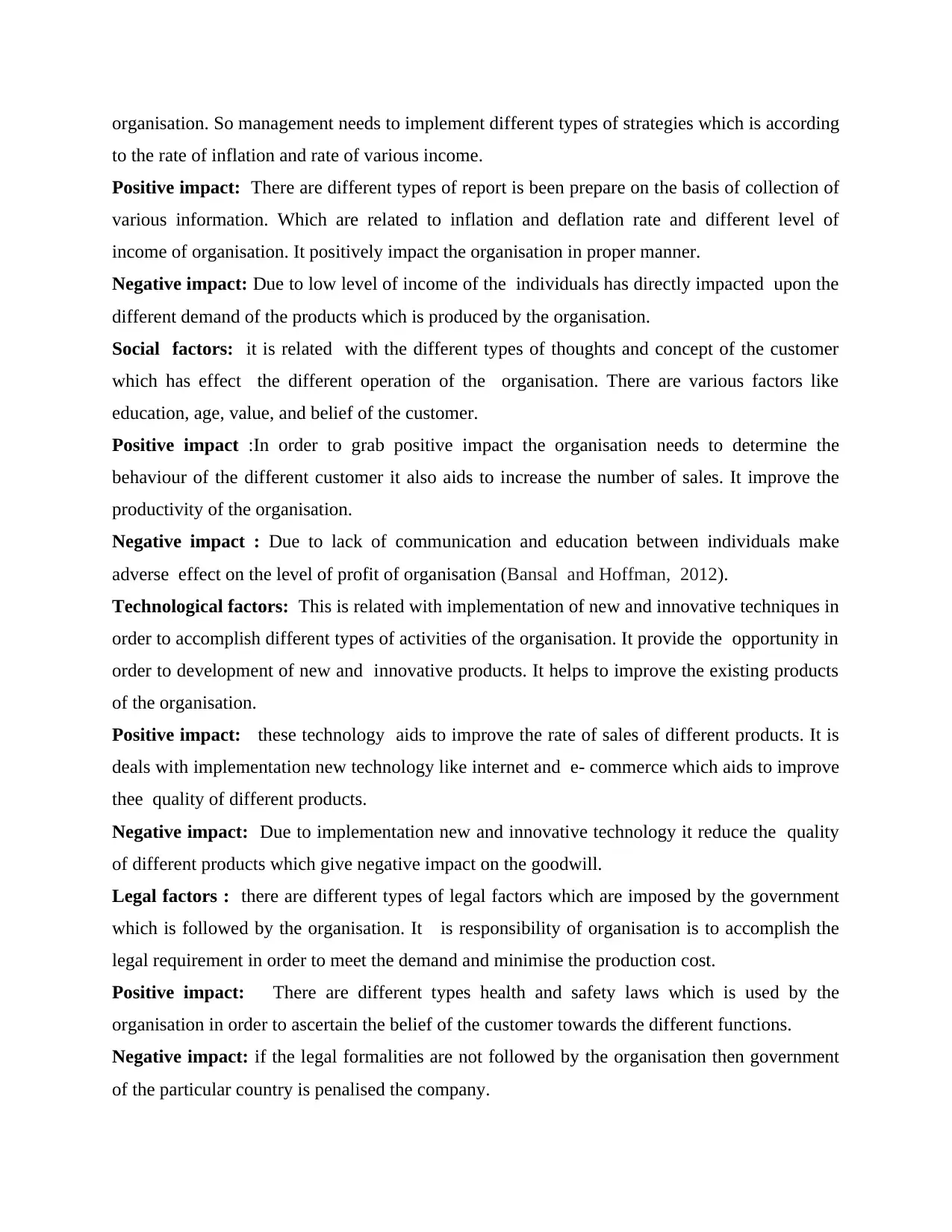
organisation. So management needs to implement different types of strategies which is according
to the rate of inflation and rate of various income.
Positive impact: There are different types of report is been prepare on the basis of collection of
various information. Which are related to inflation and deflation rate and different level of
income of organisation. It positively impact the organisation in proper manner.
Negative impact: Due to low level of income of the individuals has directly impacted upon the
different demand of the products which is produced by the organisation.
Social factors: it is related with the different types of thoughts and concept of the customer
which has effect the different operation of the organisation. There are various factors like
education, age, value, and belief of the customer.
Positive impact :In order to grab positive impact the organisation needs to determine the
behaviour of the different customer it also aids to increase the number of sales. It improve the
productivity of the organisation.
Negative impact : Due to lack of communication and education between individuals make
adverse effect on the level of profit of organisation (Bansal and Hoffman, 2012).
Technological factors: This is related with implementation of new and innovative techniques in
order to accomplish different types of activities of the organisation. It provide the opportunity in
order to development of new and innovative products. It helps to improve the existing products
of the organisation.
Positive impact: these technology aids to improve the rate of sales of different products. It is
deals with implementation new technology like internet and e- commerce which aids to improve
thee quality of different products.
Negative impact: Due to implementation new and innovative technology it reduce the quality
of different products which give negative impact on the goodwill.
Legal factors : there are different types of legal factors which are imposed by the government
which is followed by the organisation. It is responsibility of organisation is to accomplish the
legal requirement in order to meet the demand and minimise the production cost.
Positive impact: There are different types health and safety laws which is used by the
organisation in order to ascertain the belief of the customer towards the different functions.
Negative impact: if the legal formalities are not followed by the organisation then government
of the particular country is penalised the company.
to the rate of inflation and rate of various income.
Positive impact: There are different types of report is been prepare on the basis of collection of
various information. Which are related to inflation and deflation rate and different level of
income of organisation. It positively impact the organisation in proper manner.
Negative impact: Due to low level of income of the individuals has directly impacted upon the
different demand of the products which is produced by the organisation.
Social factors: it is related with the different types of thoughts and concept of the customer
which has effect the different operation of the organisation. There are various factors like
education, age, value, and belief of the customer.
Positive impact :In order to grab positive impact the organisation needs to determine the
behaviour of the different customer it also aids to increase the number of sales. It improve the
productivity of the organisation.
Negative impact : Due to lack of communication and education between individuals make
adverse effect on the level of profit of organisation (Bansal and Hoffman, 2012).
Technological factors: This is related with implementation of new and innovative techniques in
order to accomplish different types of activities of the organisation. It provide the opportunity in
order to development of new and innovative products. It helps to improve the existing products
of the organisation.
Positive impact: these technology aids to improve the rate of sales of different products. It is
deals with implementation new technology like internet and e- commerce which aids to improve
thee quality of different products.
Negative impact: Due to implementation new and innovative technology it reduce the quality
of different products which give negative impact on the goodwill.
Legal factors : there are different types of legal factors which are imposed by the government
which is followed by the organisation. It is responsibility of organisation is to accomplish the
legal requirement in order to meet the demand and minimise the production cost.
Positive impact: There are different types health and safety laws which is used by the
organisation in order to ascertain the belief of the customer towards the different functions.
Negative impact: if the legal formalities are not followed by the organisation then government
of the particular country is penalised the company.
⊘ This is a preview!⊘
Do you want full access?
Subscribe today to unlock all pages.

Trusted by 1+ million students worldwide
1 out of 17
Related Documents
Your All-in-One AI-Powered Toolkit for Academic Success.
+13062052269
info@desklib.com
Available 24*7 on WhatsApp / Email
![[object Object]](/_next/static/media/star-bottom.7253800d.svg)
Unlock your academic potential
Copyright © 2020–2025 A2Z Services. All Rights Reserved. Developed and managed by ZUCOL.





